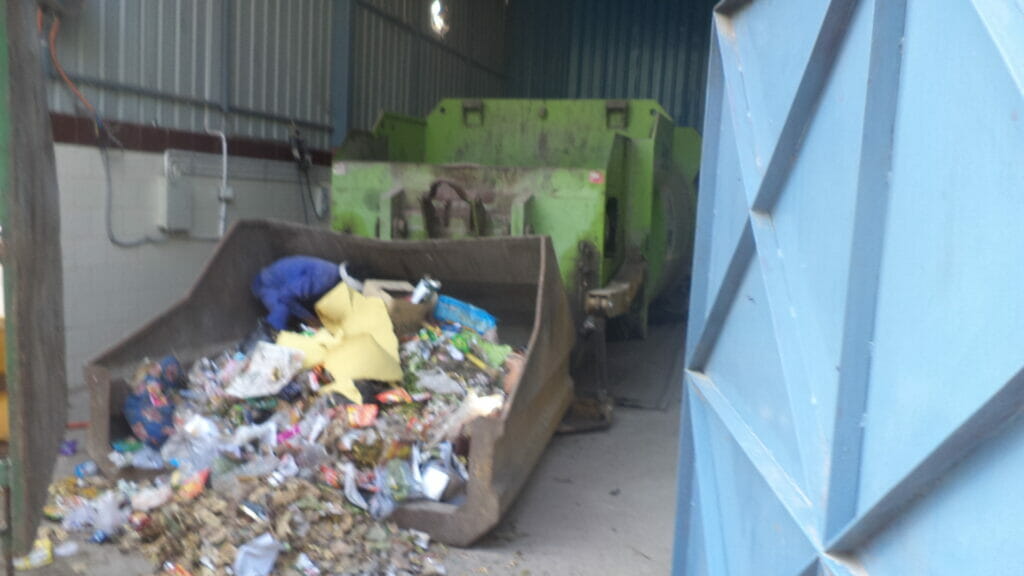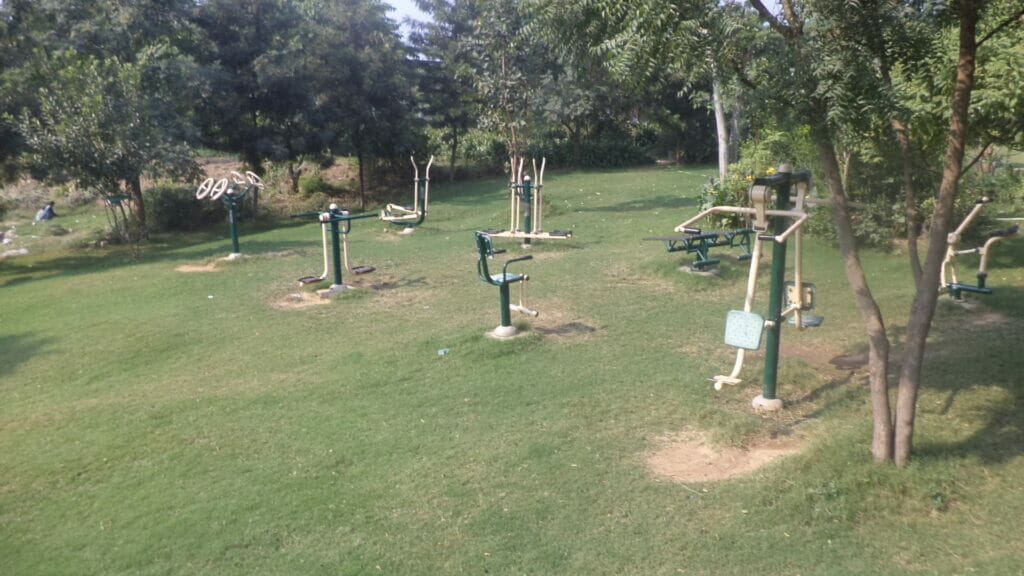Rajokri Lake, located near the Delhi-Gurugram border till 2017 was a dying water body that had suffered years of toxic abuse. Domestic wastewater and sewerage from the adjoining semi-urban settlements of Rajokri village were channelled through open drains into the lake, which became a breeding ground for communicable diseases.
As one resident of the area said, “It was hell living here. But today, we have a park where children play and an open gym”. In what had become a hub for anti-social elements, “it is now safe for women to venture out anytime,” added the resident.
The transformation was the result of four years of effort of two individuals, Ankit Srivastava, a graduate of IIT Bombay in Environmental Engineering and Advisor to Delhi Jal Board, and architect Mriganka Saxena, who saw a potential for change under all the filth. Teaming up with the Delhi Jal Board, along with the Irrigation and Flood Control Department (IFCD) the two transformed the Rajokri water body into Delhi’s first-ever decentralised sewage system.
The lake area today is 9,446 square metres of redeveloped public space, with a water body of 2,000 square metres which is now fed with treated effluents, which earlier were its primary pollutants. Gravel-based walking pathways around the lake double up as rainwater harvesting channels.
Read more: What the Jal Jeevan Mission must focus on to fix urban water supply
“The entire place was nothing but a sewerage pond,” said Hardeep, a student of class XII who has been residing in the colony adjoining the lake for over 10 years. “But now the water body has been made into a lake with trees planted and a children’s park and gym”.
One major problem, however, remains. “The garbage dump located just outside the park emanates a lot of stink and something needs to be done about it,” says Hardeep. As did several residents who have become regular visitors to the park.

The park’s security guard Suresh has been ensuring its maintenance as well as that of the tank that cleans the sewage flowing into the Sewage Treatment Plant (STP).
Inspiration to do more
Srivastava and Saxena’s success in the transformation of the water body has given huge impetus to the Delhi government’s ambitious initiative, called ‘’City of lakes”, to rejuvenate old water bodies in and around Delhi. Being implemented by the DJB in the plan’s first phase, 250 water bodies and 15 lakes have been identified for transformation.
“A 20-acre lake will be built here with the treated water,” state water minister and DJB chairperson Satyendar Jain tweeted in January. He was visiting Timarpur village in North East Delhi, where the DJB is constructing a sewage treatment plant (STP).
“The ‘City of Lakes’ project was launched on December 24, 2018, by Chief Minister Arvind Kejriwal who approved Rs 376 crore for the rejuvenation of 159 lakes in Delhi and Rs 77 crore towards the creation of two mega lakes at Rohini in North West Delhi and Nilothi in West Delhi.
Reviving traditional water bodies
Lake revival also includes the planting of trees and providing appropriate infrastructure to create public spaces. In Dwarka and Rajokri, these rejuvenated lakes are providing much-needed green public spaces for residents.
The completed projects include Hauz Khas lake, Bhalswa Lake, Smriti Van (Kondli), Smriti Van (Vasant Kunj), Tikri Khurd Lake and Najafgarh Jheel, which have led to an increase of up to two metres in groundwater levels.
“The City of Lakes project has two focus areas – lakes and water bodies,” said Srivastava. “Besides, we are trying to use the old and historic drains, canals and minors, from where we can recharge water. Also, we have got the NOC from Delhi Development Authority (DDA) to take over its 550 water bodies, while tenders have been floated for 350 water bodies and work on 50 of them is nearly over.”
As many as ten water bodies in the national capital would be declared wetlands by the Ministry of Environment, Forest and Climate Change. The identified water bodies are: Sanjay Lake, Hauz Khas Lake, Bhalswa Lake, Smriti Van (Kondli), Smriti Van (Vasant Kunj), Najafgarh Jheel, Welcome Jheel, Daryapur Kalan, Sultanpur Dabas, Poth Kalan (Sardar Sarovar Lake), says a report by the Delhi Parks and Gardens Society.
The goal is to revive all the traditional water bodies in Delhi. “As we had no model of holistic revival to follow, we created our model,” said Srivastava. The Rajokri project was taken up as a pilot project in 2017. “Here, we created an artificial lake with treated water and even built an amphitheatre.”
Rajokri Lake is better known as Chhath Ghat which attracts a large number of people for performing the puja and devotees are now able to safely take a dip in the clean lake. The amphitheatre doubles up as Chhath Ghat for public and religious gatherings.
Read more: Delhi Report Card 3: Enough ‘free lifeline water’ for all, but quality and impact under scanner
In the last few years, the Delhi government has undertaken various lake rejuvenation efforts spearheaded by the DJB, IFCD and several citizen groups. In most cases, after some initial resistance from residents, the localities in the vicinity of these water bodies are cooperating with the authorities.
Manoj Misra who is the Executive Director of the PEACE Institute Charitable Trust and Convenor, and head of Yamuna Jiye Abhiyaan, the Yamuna Forever Campaign said such projects like converting water bodies into lakes are always welcome as long as “there is no concretisation and it is done ecologically. Merely converting them into lakes is only for tourism and not a restoration.”

However, he felt that “if local people feel happy, it is okay but whether it is good for nature or not, one cannot say.”
Focus on Rajokri
“This Rajokri project had to both enhance the landscape of the area and also benefit the people on a long-term basis,” says Saxena who did the landscaping of the surrounding areas. “Hence the design was strategized in a manner that the structure could easily be maintained by the surrounding communities. Additionally, there were many environmentally responsible and sustainable guidelines that we were following under the guidance of the National Green Tribunal (NGT). From doing the green landscaping with native plant species to creating percolation pores for groundwater recharge, many elements were added to enhance the value of the project.”
As regards the garbage dump located on the periphery of the wall running around the Rajokri lake whose stink pervades inside the well laid out park, she said it was indeed unfortunate and “it has to be flagged and there is a need to clear it.”
Srivastava said that in Rajokri, the original plan did not have any provision for a Chhath ghat. However, they got inputs from the nearby communities that celebrate Chhath Puja, who said they want a small bifurcation of the water body exclusively for their religious activities. So a small, natural wall was constructed in the water body which cost around Rs 20 to Rs 30 lakh. Once the water body was completed, the residents around the lake took responsibility for its maintenance.
The rejuvenation plan was in two parts. One, construction of a wetland system and two, landscape, civil, electrical and horticulture work including maintenance for five years. The work was based on a scientific wetland system with active biodigesters (SWAB), as opposed to the standard approach of chemical treatment.
Creating wetlands
The lakes rejuvenation project is primarily aimed at creating reservoirs to stop urban flooding and prevent choked drainage. The government also wants to enhance the aesthetic value of the landscape by ecologically reviving it and restoring the local flora and fauna.
As Sushmita Sengupta, Senior Programme Manager, at the Centre for Science and Environment (CSE) said, “If they are going into the health of the water bodies, it is a really good initiative. If it can improve the quality of water, while also looking at groundwater recharge and flood mitigation, it would be good.”
While appreciating the Delhi government project of converting these water bodies into lakes, she felt that “there should be regular monitoring of the quality of water in these places and (the authorities should) ensure that the water doesn’t contain any odour or is not contaminated. Besides, the monitoring of these water bodies should be made public.”
According to DJB officials, villages had stopped getting adequate water due to rapid urbanisation. This is why rejuvenating water bodies are looked at as a solution to create a buffer zone to store, recycle, and reuse rain and wastewater.
DJB has also set up separate budgets for water bodies and lakes. According to officials, DJB has approved Rs 1-1.5 crore per acre for each water body, inclusive of operational and maintenance costs. For lakes, it is Rs 1-1.5 crore. For example, for the 60-acre Rohini Lake, the government has allocated Rs 64 crore.
“Initially, the plan appeared to be a difficult task,” said Dr Rakesh Kumar, an Officer on special duty, at the Council of Scientific and Industrial Research (CSIR). “It was after successful pilot projects like the one in Rajokri, we thought of planning. The lake rejuvenation process will raise groundwater levels. Following which, locals will start depending on treated water from the water bodies, instead of supply from the government.”
Kumar added a note of caution though. “Protecting a water body by building boundary walls around it acts as a death knell,” he added. “The lakes will dry and die, like the Roshanara and Shahdara lakes, currently being restored.”